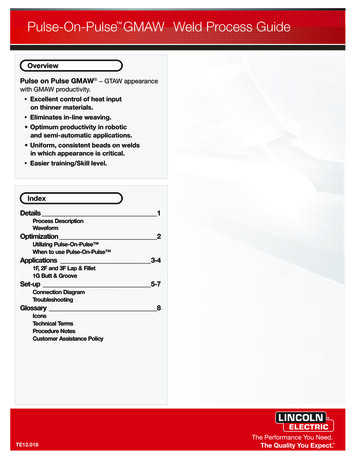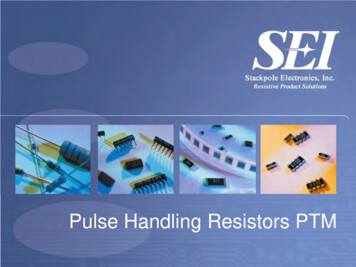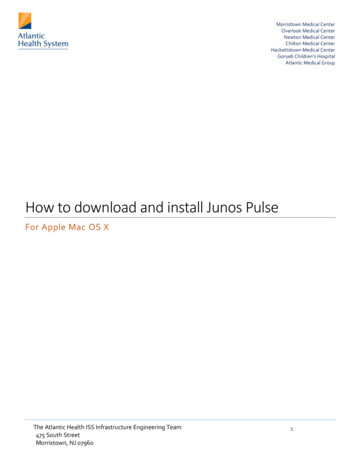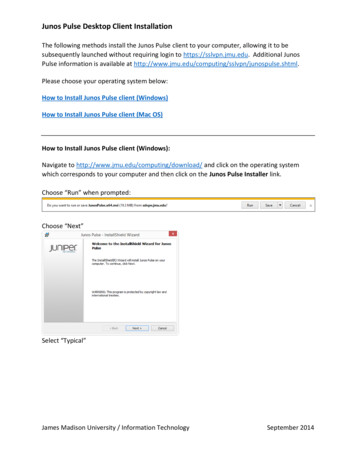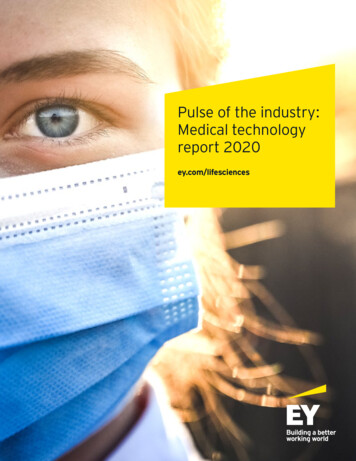
Transcription
Pulse of the industry:Medical technologyreport 2020ey.com/lifesciences
To EY clients and friendsAs EY teams began the planning for the 14th annual Pulse ofthe industry report in late fall 2019, little did we imagine howdifferent this year would be for all of us. EY teams initial planwas to take stock of the industry, focusing this edition on theroughly 10-year period following the financial crisis and howthe fundamentals of the industry have evolved over that timeframe. As with the previous 13 editions, the basis for comparisonalways starts in the quantitative realm. Leading with valuations,transactions, capital allocation and investments has always beenthe basis for our perspective on the industry.As we publish this report in fall 2020, the story is much more about medtech as acommunity, not an industry. While we still look to metrics and comparisons for insight, thecommunity aspects of our existence are where we find not only insight, but inspiration.Confronted with the advance of this major pandemic, medtech has stepped up to the clinicalfront line and played a critical role in the attempts to defuse the crisis. From mass-producingventilators, sterilizing equipment, face masks and other protective personal equipment, toinventing and distributing the rapidly expanding range of diagnostic tests now reaching themarket, the industry has achieved an incredible amount in the first half of 2020. Medtech’swork has saved lives, allowed medical facilities to keep running, enabled patients to betreated in hospitals or at home, and overall made it possible for normal operations to bemaintained, while simultaneously also helping health systems, governments and the generalpublic wage a global health battle on a scale not previously seen this century.In August 2020, Ernst & Young Global Limited co-hosted two CEO panels with our colleaguesat AdvaMed, and the first question to the group was, “what are you most proud of overthe last six months?” The groups spoke passionately about the innovation, collaborationand determination that have characterized medtech’s response to COVID-19 pandemic.It was clear that this community is truly connected by a universal sense of purpose in theextraordinary care shown for patients, clinicians and employees. It is also evident that helpingto solve this crisis as a community has provided an opportunity to accelerate much neededand lasting change across the industry.2 Pulse of the industry: Medical technology report 2020
So, today, our perspective is centered on the 10 years between two crises, with the secondone yet unresolved. As the ongoing high valuations for medtech in 2020 show, investorscontinue to recognize the importance of medtech. The industry demonstrated its resilienceover the decade of steady growth and solid valuations, and even though 2020 looks tohave delivered a negative (though possibly very transient) financial blow to some sectors ofthe industry, other areas, such as the diagnostics segment, have surged over the past fewmonths. Moreover, this most recent crisis will help illuminate the way to a brighter future forthe industry, by demonstrating the need to futureproof business models, strengthen supplychains and ecosystem relationships, and accelerate the progress of digital technology anddata. The COVID-19 pandemic has shown us that we can accelerate progress in all of theseareas and that by delivering innovation through the use of data and digital technology, wewill secure the future of this industry, and our community.We firmly believe that individuals and groups show their true colors under pressure, andmedtech has risen to the challenge of the pandemic, demonstrating its medical, economicand societal value, and showing why it is an essential industry for the whole world. In closing,I’d like to take the time to express a strong vote of confidence toward the industry for the vitalrole it has played in the efforts to contain COVID-19 pandemic, both in the United States andacross the globe.In this, the 14th annual Pulse of the industry report, we attempt to take stock of anextraordinary year for the medtech industry and for the rest of the world.Jim WelchEY Global Medical Technology LeaderPulse of the industry: Medical technology report 2020 3
4 Pulse of the industry: Medical technology report 2020
Contents06The year in review08A new decade, new disruption — and a new dawn?Where medtech stands in the Now20Opportunities from the crisis: where medtech isheading in the Next and Beyond36Guest perspectivesScott Whitaker, CEO & President, AdvaMedDr. Andre Chow, Vice President and General Manager Digital Surgery, MedtronicDr. Jean Nehme, Vice President of Business Development & StrategicPartnerships, Digital Surgery, MedtronicMark Benson, Vice President, Medical Devices Supply Chain, Johnson & JohnsonNicholas Galakatos, Global Head of Life Sciences, BlackstoneAloha McBride, EY Global Health Leader48Databook68Scope of this report70Acknowledgments72ContactsConnect with us!Twitter: @EY Healthey.com/lifesciencesPulse of the industry: Medical technology report 2020 5
The yearin review6 Pulse of the industry: Medical technology report 2020
6.3%(2019)In 2019, total US and Europeanmedtech revenues grew 6.3%, slightlyless than the 6.7% recorded in 2018.However, during the first half of 2020,revenues of US commercial leaders andconglomerates declined 5.0%, as manymedtechs were negatively impacted bythe COVID-19 pandemic.11.5%(H1 2020)B ut the industry returneda record US 19.6b toshareholders in 2019.R &D spending in 2019 grew 11.5% (compared withan increase of 8.1% last year), marking a returnto the double-digit rates common in the industrybefore the 2007–08 financial crisis.US 57.1b-5.0%US 19.6bF inancing levels more than doubled fromJuly 2019 to June 2020 compared with theprevious 12 months — with over 40% resultingfrom debt financing.US 3.2b22%Medtechs garnered US 3.2b in IPOvalues — the third highest on record —however, just 3 deals represented 5%of the total, and the number of deals(14) was the lowest in a decade.A fter three straight years of recordinvestment, venture capital fundingfell 22%, with Q2 2020 beingparticularly anemic.US 40.5b41%Total M&A deal values plunged 60%from US 67.6b the year before toUS 27.1b, partially reflecting the lossof the year’s largest announced deal.The total value of non-megadeals (thoseunder US 10b) dropped 41%, whileaverage deal value across the industryshrank from US 463m in the prior12-month period to US 167m.Pulse of the industry: Medical technology report 2020 7
A new decade,new disruption —and a new dawn?Where medtechstands in the Now8 Pulse of the industry: Medical technology report 2020
It’s too early to assess the ultimate effect of COVID-19 onthe medtech industry. Throughout this report, we haveconsidered some of the early signs around changes thepandemic is currently bringing to the industry’s businessmodels, supply chain operations, regulatory regime,and embrace of digital and data-led transformation.First, however, we will take stock of the key metrics formedtech: the industry’s financial performance, financingsituation and M&A activity. The activity seen in thesemetrics across 2019 and into 2020 gives us perspectiveon the state of the industry before and during the currentcrisis, and it provides us with a basis to assess medtech’sprospects after the pandemic is past.Between the financial crisis and the pandemic:medtech’s years of steady growthThroughout the 2010s, the medtech industry maintained its solid financialperformance year after year. While the financial crisis of 2007 and 2008 wasa heavy blow to medtech and many other industries, the following decadewitnessed a medtech resurgence due to strong fundamentals and investors’ highconfidence in the sector (see Figure 1). Though annual growth in revenues hadyet to recapture the heights of the early years of the 21st century, 2019 saw theindustry earn one more year of respectable single-figure growth (6.3%).In another encouraging sign, medtech’s 2019 R&D investment grew by 11.5%compared to 8.1% in 2018, marking a return to the double-digit R&D growth ratesregularly recorded before the financial crisis. For an industry driven by research,this is a positive sign, suggesting confidence in medtech’s ability to keep creatinginnovative and profitable new products.Pulse of the industry: Medical technology report 2020 9
Figure 1. Medtech 0320%200225%200124%Annual R&D spending growth (%)Post-financial crisis30%2000Annual revenue growth (%)Pre-financial crisis-5%RevenueR&DSource: EY, company reports.Then came COVID-19.Though we don’t have full-year 2020financial data to assess the impact ofthe pandemic (and the socioeconomicchaos it has brought in its wake) onmedtech, we can already recognizethat the industry’s financials in 2020will look nothing like 2019 or any otheryear over the previous decade.An analysis of Q1 and Q2 2020financial reporting indicates thatroughly two-thirds of US commercialleaders (pure-play medtech companieswith more than US 500 million inannual revenue) and conglomerateshave experienced an aggregaterevenue decline of 5%. However,this figure conceals wide variations.Among companies focused on electiveprocedures, the impact has been higher,as patients have stayed away fromhospitals where COVID-19 dominatedclinical priorities in the second quarterof 2020. By contrast, companiesfocused on diagnostics saw toplinesrise significantly with the heighteneddemand the pandemic brought (seeFigure 2).However, the immediate financialeffects, good or bad, are only half ofthe story unfolding in 2020. WhileCOVID-19 has hit revenue growth, thereare signs that the industry may reboundrapidly in the second half of the year.Some early data suggests a “V-shaped”recovery in the elective space, as10 Pulse of the industry: Medical technology report 2020surgeries resume and surgeons advisepatients to undergo procedures soonerrather than later with the future courseof the pandemic still unpredictable.Beyond this, COVID-19 has broughtsignificant opportunities, as well aschallenges, in medtech. The industryhas been at the forefront of effortsto fight the outbreak (see Figure 3),raising its profile and consolidatingits reputation as a good partnerand “a must-have industry,” as oneparticipant described it at the firstErnst & Young LLP/AdvaMed medtechCEO roundtable in August 2020.As this roundtable series revealed(see Insights from the first and secondErnst & Young LLP/AdvaMed medtechCEO roundtable below), medtechhas adapted creatively during the
Figure 2. COVID-19 impact on US medtechs* during the first half of 2020Aggregate revenue decline is 5%.2/3 of medtechs report revenue drop in H1 2020.7 of the top 10 companies by revenues report H1 2020 downturns vs. H1 2019.Eight companies, primarilyfocused on elective procedures,saw revenues fall by 15% ormore . but diagnostic companiessurged, accounting for fourof the six biggest revenueincreases:Envista Holdings: -34%Dentsply Sirona: -30%Zimmer Biomet: -24%NuVasive: -18%Exact Sciences: 70%Quidel: 47%Dexcom: 39%Masimo: 24%Source: EY and public company filings.*Includes US-based commercial leaders and conglomerates.Pulse of the industry: Medical technology report 2020 11
Figure 3. Selected examples of medtech’s role in the COVID-19 responseAs of August 2020, therewereCOVID-19-relateddiagnostics launched in market orin development; 219 were fromUS manufacturers; 187 fromEurope.448452 partnerships have been219 FDA-clearedThere wereCOVID-19 tests;identified — the vast majoritywere driven by biopharmas(270), but medtechs did have56 — mostly focused on digital,diagnostic testing development,scaling manufacturing andtelemedicine and virtual care.155 focused on diagnostic —molecular PCR tests; 39 focusedon serology.crisis, strengthening its relationshipswith its customers and acceleratingthe progress of its next-generationtechnologies into clinics and homes.Medtech’s response to the events of2020 has important implications in atleast four major areas: business modelevolution; supply chain resilience;regulatory relationships; and theaccelerated advancement of digitaltechnologies that can capture, analyzeand use data. The impact of COVID-19in each of these areas is exploredfurther later in this report.First, however, we turn our focus to theindustry’s fundamentals, as shown inthe data for 2019 and 2020 to date.Is medtech in a position to ride outthe disruptions of 2020 and regain oreven surpass its performance acrossthe 2010s? Examining the industry’smost recent financial performance,financing and M&A data gives us amostly affirmative answer — though notwithout some underlying causes forconcern, too.“. a key driver ofmedtech’s high valuationswas the non-imagingdiagnostics segment .12 Pulse of the industry: Medical technology report 2020232 were focused on viralin-vitro diagnostics; 148 wereantibody in-vitro diagnostics.734There aredrugs andvaccines in development (544drugs and 190 vaccines).Among these vaccines, 152 arepreclinical; only 8 are in Phase III.Medtech valuations riseagain in 2020When we look at medtech’s keymetrics in 2020 to date, onereassuring measure stands out:investor confidence. Though medtech’svaluations fell along with the broadermarket (bottoming out in late March2020), they recovered strongly in thesubsequent months (see Figure 4). Bythe end of August 2020, medtech’svaluations were up 50% compared toJanuary 2019; much stronger than therebound for broader composite indicessuch as the New York Stock Exchange(NYSE) and the S&P 500 (up 15%and 40%, respectively, over thesame period).
Figure 4. Medtech’s valuations resurgent in Q2 and Q3 2020US and European medtech market capitalization relative to leading indicesEY medtech commercial leadersRock Health Digital Health Public Company IndexNASDAQ Biotechnology IndexEY medtech noncommercial leadersBig pharmaComposite broader eb2019Mar2019Apr2019May2019June2019Though digital health companiesrebounded even more strongly (up65%, likely due to investor excitementover enhanced use of virtual healthand other remote technologies duringthe COVID-19 pandemic), medtech’scommercial and noncommercial leadersboth comfortably outperformed bigpharmaceutical companies (whichsaw valuations rise 18% compared toJanuary 2018) and biotech companies(up 40%). This highlights the perceivedreliability of medtech as an investment,free from the controversies overpricing, for example, that generatepolitical head winds for big pharma.When we dig deeper into thesenumbers, it is clear that a key driver ofmedtech’s high valuations was the 2020imaging diagnostics segment, whichsaw valuations rise 116% betweenJanuary 2019 and August 2020, morethan twice as much as for any othersegment. In part, this reflects theurgent need for new diagnostic toolsto combat COVID-19: For instance,Quidel, saw its overall valuation jump331% between January 1, 2019 andJune 30, 2020, partially aided by theU.S. Food and Drug Administration’s(FDA) emergency use authorization(EUA) approval for its Sofia SARSAntigen FIA rapid point-of-care test forCOVID-19 in early June 2020.Yet the strong performance ofdiagnostics predates the pandemic andreveals an important underlying trendwithin 20Aug2020Revenues: diagnostics onthe front lineThe high levels of waste in healthcare spending are a matter of record,and the inefficiency (in terms ofcost) and ineffectiveness (in clinicalterms) of treating patients with a“one-size-fits-all” approach are widelyacknowledged. Recognition of thesefacts has increasingly prompted callsfor a more personalized approachto medical treatment. Of necessity,diagnostic tools are at the heart of thisnew approach, since they offer meansto build a detailed and individualizedunderstanding of patient health andPulse of the industry: Medical technology report 2020 13
Figure 5. Non-imaging diagnostics at the forefront in 2019Non-imaging diagnostics led all product categories in revenue growthChange in number of companies in gnosticsResearch and otherequipmentTherapeutic devicesPercentage change in number of companiesPercentage change in revenueChange in revenue-6%Source: EY, Capital IQ and company financial statement data.Data shown for pure-play companies only.illness. In recent years, this vital rolefor diagnostics has been reflected inthe performance of this segment of themedtech market.In 2019, the non-imaging diagnosticssegment recorded 12.2% revenuegrowth (see Figure 5). This would makediagnostics the strongest performerin medtech, with therapeutic devices,the next strongest, recording only7.7% growth. However, when Novartis’spinoff of Alcon as a stand-alonecompany is accounted for (causinga large shift of revenue from theconglomerates category into pure-playtherapeutics), the therapeutic devicessegment’s growth rate climbs to 12.5%for the year.As we saw in the analysis of valuations,the non-imaging diagnostics segmentis booming in 2020, with COVID-19related diagnostics needed in bulk onthe clinical front line. Yet COVID-19could act as a growth driver for nonimaging diagnostics in the longer termas well. To take one example of the2019 performance of non-imagingdiagnostics, Exact Sciences’ revenuesurged 93% to US 876 million as useof its Cologuard at-home colon cancertests doubled to 1.7 million. Thisillustrates the growing demand both forprecision medicine and for individualsto be able to obtain a diagnosiswithout attending a hospital or clinic.This demand will be amplified by thesituation in 2020, with individuals now14 Pulse of the industry: Medical technology report 2020having even stronger incentives toavoid in-person attendance at clinicswhere possible.Whether non-imaging diagnostics, andthe broader medtech sector, can sustainthis revenue growth in the longer termdepends on the sector’s ability to keepinnovating and bringing new productsto the market. This, in turn, dependson medtech’s underlying financing.Here, the impact of COVID-19 is evidentin 2020.
Figure 6. Medtech funding surges, but cheap capital and debt financing are the main causeCapital raised in the US and Europe by yearVentureIPOFollow-on and otherDebt6050US b403020100July 2010–June 2011July 2011–June 2012July 2012–June 2013July 2013–June 2014July 2014–June 2015July 2015–June 2016July 2016–June 2017July 2017–June 2018July 2018–June 2019July 2019–June 2020Source: EY, BMO Capital Markets, Dow Jones VentureSource and Capital IQ.Numbers may appear to be inconsistent because of rounding. Private investments in public equity included in “follow-on and other.”Financing: major playersload up on debt asstartups face uncertaintyMedtech’s financing levels more thandoubled to a record US 57.1 billion inthe 12-month period from July 2019to June 2020, compared with theprevious 12 months (see Figure 6).Over 40% of this dramatic growth wasa result of US 35.6 billion of publicdebt financing, fueled by historicallylow interest rates. In fact, a record 18companies raised US 500 million ormore, with Thermo Fisher Scientificalone accounting for US 9.2 billionof the total. As yet, it is unclear towhat extent this rise in debt financingrepresents either companies drawinginto their credit reserves to allayfinancial concerns arising from thepandemic, or companies raisingmore financing to increase investmentin innovation.However, it is clear that both debt andfollow-on fundraising (which constitutedroughly another US 11.8 billion – 23%of the period funding total) was drivenby medtech’s bigger players, ratherthan the smaller companies that forma key component of the industry’s R&Dengine. Overall “innovation capital”(money raised by the industry’snoncommercial leaders) slid toUS 18.4 billion, accounting for only32% of total funding (down from theprevious 10-year average of 47%).The IPO and venture capital (VC)fundraising channels saw less activitythan debt and follow-on financing overthe same 12-month period, whichpresents a challenging landscape forearly-stage companies reliant on thesefinancing options. Josh Makower,MD, a general partner with venturecapital firm NEA, told us that while“companies whose work can proceedwithout being impacted by the stateof elective surgeries are seeing goodvaluations and good financings,” others“will experience a higher challenge inobtaining capital right now and mayneed to rely on insider’s capital toextend runway, or they may face downrounds or valuation resets if they mustraise externally.”Pulse of the industry: Medical technology report 2020 15
Figure 7. Medtech IPOs were down againUS and European medical technology IPOs by periodCapital raisedNumber of 105July 2019–June 2020July 2018–June 2019July 2017–June 2018July 2016–June 2017July 2015–June 2016July 2014–June 2015July 2013–June 201416 Pulse of the industry: Medical technology report 2020July 2012–June 2013Source: EY, Capital IQ, BioCentury and Dow Jones VentureSource.July 2011–June 2012July 2010–June 2011July 2009–June 2010July 2008–June 2009July 2007–June 2008July 2006–June 2007July 2005–June 20060.080Number of IPOsCapital raised in IPOs (US b)6
While the US 3.2 billion total for IPOswas the third highest on record, just 3deals constituted roughly 85% of thatvolume, and the number of deals (14)was the lowest in a decade (see Figure7). The biggest IPO illustrates the trendtoward virtual health: SmileDirectClubraised almost US 1.4 billion through itsSeptember 2019 IPO. SmileDirectClubhas developed a “teledentistry” modelin which consumers can use an athome kit to make an impression of theirteeth and then receive custom alignerswithout going to an orthodontist. TheCOVID-19 pandemic is now acceleratingthe demand for these types of businessmodels. Yet most of the IPO volumein the 12-month period consideredhere was concentrated in Q3 2019,before COVID-19 had an impact. IPOactivity fell precipitously in the first twoquarters of 2020.In the meantime, after three straightyears of record VC investment, thetotal for the most recent 12-monthperiod fell by 22%, with Q2 2020 beingparticularly painful — presumablyreflecting the impact of the pandemic.Moreover, early-stage companiessecured a smaller proportion of thetotal in this period (43%) than in theprevious 12-month period (52%)(see Databook), suggesting possiblechallenges in funding early innovation.It’s notable that non-imagingdiagnostics, once again, have beena major target for venture activity.The biggest US VC round sawNorthern California-based Karius raiseUS 165 million for its Karius Test bloodtesting technology platform, whichcombines genomics and AI to spot traceDNA marking the presence of infectiouspathogens. The top VC round overallwent to UK-based CMR Surgical Limited,which makes the next-generationVersius surgical robotics system.Surgical robotics have been a standoutin the therapeutic devices segmentin recent years, with market leadersMedtronic and Johnson & Johnsonboth investing in multibillion-dollaracquisitions in this maturing technologyspace (see the guest perspective fromDr. Jean Nehme and Dr. Andre Chow,cofounders of Digital Surgery, whichMedtronic acquired in 2020).“. after three straight yearsof record VC investment,the total for the mostrecent 12-month periodfell by 22% .Pulse of the industry: Medical technology report 2020 17
M&A: will the pendulumswing back in 2021?The disruptive impact of the COVID-19outbreak is particularly evident inthe industry’s M&A performance,with M&A expenditures from July2019 to June 2020 plunging 60%to US 27.1 billion compared to theprevious 12-month period (see Figure8). An already-low total deal value wasfurther reduced when Thermo FisherScientific was rebuffed on its proposedUS 12.5 billion acquisition of Qiagenin August 2020. Focused on moleculardiagnostics, including in infectiousdisease, Qiagen saw its operatingincome jump 84% in the first six monthsof 2020 due to the impact of COVID-19,leaving its shareholders reluctantto accept Thermo Fisher Scientific’senhanced offer.more milestone payments (a strategythese companies frequently employedduring the aftermath of the 2007 and2008 financial crisis).Leader; “if we as an industry get somesense of normalcy into the fall, the highlevel of available capital could trigger anM&A acceleration,” he continued.There are signs, however, that thebig medtech players may instead becontemplating a surge of acquisitions inthe near future. A buyer’s market maybe developing as smaller, and perhapseven midsize, companies questionwhether they can survive the economicuncertainty triggered by the COVID-19pandemic. Meanwhile, as noted, largemedtech companies have recapitalizedthrough debt and follow-on offerings,and now have substantial M&Afirepower. “The industry anticipatesan accelerated growth cycle, withcompanies valued at US 30 millionto US 40 million becoming targets,”suggests John Babitt, EY AmericasStrategy and Transactions MedtechThis is one of the areas to watchover the coming year in medtech.The industry has retained investorconfidence as reflected in its valuationsand shows early signs of a reboundingfrom the COVID-19-related revenuehit, with the non-imaging diagnosticssegment in particular thriving. Thereare more mixed signals in the financingand M&A data, suggesting the currentuncertainty about the future.Yet, as discussed throughout thisreport, there are also substantialreasons for medtech to be positiveabout the future – with COVID-19’slong-term impact not constraining theindustry, but potentially driving growthand transformation.The next-biggest deal – Stryker’sUS 5.4 billion proposed acquisition oforthopedic company Wright Medical– is under regulatory review in the USand the UK as of September 2020.However, the impact on M&A is notconfined to the fall in such “megadeals”(those worth over US 10 billion): thetotal value of non-megadeals has alsodropped 41%, while the average dealvalue across the industry shrank toUS 167 million (from US 463 millionin the previous year).The slowdown in M&A, IPOs andVC funding raises concerns thata major source of innovation willdisproportionately impact startupsand small companies that are relianton this capital. To sustain the cycle ofinnovation, larger medtech companiesmay need to consider other approaches,such as partnerships, incubators and18 Pulse of the industry: Medical technology report 2020
Figure 8. Total deal values decline in 2019–20M&As in the US and Europe by yearMegadeals ( US 10b)Other M&As200176 deals163 dealsTotal deal value (US b)48146 deals134 deals36160120101 deals248012400July 2015–June 2016July 2016–June 2017July 2017–June 2018July 2018–June 2019July 2019–June 2020Number of deals600Source: EY, Capital IQ, Thomson ONE.Pulse of the industry: Medical technology report 2020 19
Opportunitiesfrom the crisis:where medtechis heading in theNext and Beyond20 Pulse of the industry: Medical technology report 2020
We now turn our focus to the evolutionmedtech is undergoing in 2020. Thisevolution is not solely a result of theCOVID-19 crisis; on the contrary,the underlying drivers for medtech’stransformation have been increasinglyevident in recent years, and have beenexplored in recent editions of this report.The rise of connected devices is drawingmedtech into the internet of thingsand opening up new opportunities fordata-driven improvements in clinicaloutcomes; growing cost constraints onhealth care systems; establishing theimpetus for providers to assist medtechin reshaping its business models andecosystem relationships; and seeingpatient-consumers’ increasing demandsfor a more customer-centered health careexperience. These drivers of change wereall recognized by the medtech industryprior to 2020.Pulse of the industry: Medical technology report 2020 21
However, COVID-19 has increasedthe urgency for medtech to respondto these drivers and to accelerate itstransformation. The challenge of theCOVID-19 pandemic has highlightedthe room for improvement in medtech’sbusiness models, supply chainsystems, regulatory relationships, anddeployment of digital and data tools.The industry now has the chance toaddress these limitations and placeitself in a better position to thrive in thenext and the beyond.First, we consider the impact thepandemic has had on business models,and how medtech can capitalize onthis change.Changing business models58% of them increasing it by over 50%.“It was always going to happen in fiveyears, but instead it happened in fivemonths,” one participant told the firstEY/AdvaMed medtech CEO roundtable,on 4 August 2020 (see Insights fromthe first EY/AdvaMed medtech CEOroundtable below).By the end of the 1950s, thetechnology for virtual health servicesalready existed: two-way interactivevideo and voice contact, piloted byNASA to monitor astronauts’ vital signs,was already allowing communicationbetween the Norfolk State Hospitaland the Nebraska Psychiatric Institutein Omaha, 112 miles away. And yet,six decades later, at the beginning of2020, 80% of physicians in the US werenot using virtual health in their patientinteractions (see Figure 9).The lesson here is that technologies canexist for years before external eventstrigger the wholesale shift towardbusiness models that can capitalize onthose technologies. For virtual health,it was the COVID-19 pandemic thatpulled the trigger. One of the leaders invirtual health, Teladoc Health, reportedthat in Q2 2020, its appointmentvolume had grown over 200% comparedto Q2 2019.1 Within a week of thisAnd six months after that? Ninety-fivepercent of physicians had increasedtheir use of virtual technology, withFigur
chains and ecosystem relationships, and accelerate the progress of digital technology and data. The COVID-19 pandemic has shown us that we can accelerate progress in all of these areas and that by delivering innovation through the use of data and digital technology, we will secure the future of this industry, and our community.




